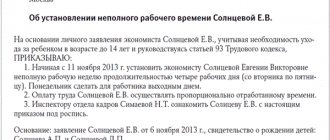Many employment-related relations in our country are regulated by the Labor Code of the Russian Federation.
According to many experts, this document should be a reference book for a modern leader .
By carefully studying all the provisions and aspects of labor legislation, it is possible to avoid conflict situations, inspections, and often considerable fines imposed by inspection bodies.
First of all, you need to figure out what is a work shift?
This is the duration of working time (in hours and minutes) during the day, according to the schedule at the enterprise (organization), i.e. the time the employee performs his duties in accordance with the employment contract.
The duration of a work shift is determined from the moment it begins and ends; breaks can be established by labor regulations, and in case of shift work - in accordance with shift schedules.
Maximum
Legislative acts do not establish the maximum duration of a work shift, but regulate the weekly maximum permissible amount of work, which should be no more than 40 hours for a five-day work week and 36 hours for a six-day work week.
These standards cannot be increased even by agreement between employees and the employer.
An exception may be cases specified in the law, an example would be overtime work. The employer records overtime hours worked individually for each employee.
Information about working hours may also be specified in other acts that are not related to labor law. An example is the order of the Ministry of Transport of the Russian Federation dated January 30, 2004 No. 10, which establishes the duration of the work shift for workers managing air transport of civil aviation of the Russian Federation.
When keeping records of hours worked using the summarized method, the duration of such an employee’s work shift should not exceed 9 and 12 hours, respectively, during the day and night.
Length of irregular working hours
The duration of working hours is influenced by the establishment of irregular working conditions for individual employees. In this case, they have to perform work duties not only within a strictly regulated time frame, but also in excess of the established standards. At the same time, the working hours of such workers on different days may vary in duration.
IMPORTANT! The condition for irregular working hours must be reflected in a separate internal local act or in an employment contract with the employee (Article 57 of the Labor Code of the Russian Federation).
Read about the structure of the employment contract in the material “Unified Form No. TD-1 - Employment Contract.”
For an employee, the condition of an irregular working day means the following:
- he has the right to involve him in work both before the start of the work schedule and after its completion;
- there is no need to obtain the employee’s consent to work after hours;
- if additional presence at the workplace is not required from the employee, then the boundaries of working time for him are the usual duration of work established in the company.
IMPORTANT! An irregular RD gives the employee the right to receive monetary compensation (additional payment) (Article 152 of the Labor Code of the Russian Federation) and additional leave of at least 3 days (Article 119 of the Labor Code of the Russian Federation).
The duration of a non-standardized work schedule is limited only by the minimum time frame - it cannot be less than the duration of the work day established by the company. The legislation is silent about the extent to which the employer has the right to extend the working hours during irregular work hours.
The following measures will help to avoid abuse on the part of the employer in extending the work permit:
- the list of positions with non-standardized work orders should be fixed in a collective agreement or an internal local act (by agreement with the trade union);
- identify the main group of issues that require the involvement of workers outside the normal duration of working days;
- determine situations when, in order to engage in overtime work, a written and when a verbal order from the employer is required;
- clarify other important points (frequency of involving certain workers in irregular work, if possible, determine the maximum time frame, etc.).
For certain categories of citizens
For some categories of citizens, the Labor Code establishes different standards for the duration of work shifts.
For schoolchildren and students who study in general education institutions and vocational education institutions, combining study with work, the duration of a work shift cannot exceed two and a half hours for the age category 14...16 years and four hours for the age category 16...18 years.
Teenagers aged 15...16 years can work no more than five hours daily, and those aged 16...18 years - no more than seven hours. However, they should not be classified as students.
When hiring disabled people , the employer, in order to approve the length of the working day for such applicants, must rely on a medical certificate issued by the relevant institution in the manner prescribed by law.
For workers whose working hours have been reduced due to dangerous and (or) harmful working conditions , the longest working day cannot be more than 6 and 8 hours with a weekly schedule of 30 and 36 hours, respectively.
The daily shift of such employees can be increased to 12 and 8 hours when working 36 and 30 hours per week, respectively, only with their written consent .
However, here you should not forget about keeping records of the time worked by each employee individually and ensure that the maximum weekly duration .
For example, a general worker who works on the basis of pesticides and chemical fertilizers has the following work schedule : a five-day workday with a total duration of 30 hours. From Monday to Wednesday, the employee worked as usual and worked 18 hours.
Due to necessity, the duration of the shift on Thursday (one-time increase), with the written consent of the worker, was 8 hours . Then on Friday this employee must appear on duty for four hours.
For workers in creative professions, the daily shift duration is established by an employment contract, collective agreement, or local regulations of the organization.
The impact of breaks on the length of the working day
Based on the inclusion of break time in the work schedule, they can be classified into 2 groups:
- increasing the duration of taxi trips, but not subject to payment;
- not affecting the duration of the RD.
Employment contracts and internal local acts (for example, the Regulations on remuneration) contain instructions on the beginning and end of working hours and rest breaks. For example, from 09:00 to 18:00 with a lunch break from 13:00 to 14:00.
In fact, under this regime, the employee is at work for 9 hours, which exceeds the normal 8-hour workday duration. However, this is not quite true.
IMPORTANT! The duration of the break for rest and food is not included during working hours. The minimum and maximum duration of breaks is regulated by Art. 108 of the Labor Code of the Russian Federation - no less than 30 minutes and no more than 2 hours.
So the breaks:
- are provided in accordance with labor legislation (Article 108 of the Labor Code of the Russian Federation);
- the duration, number and specific time frame of breaks are established by internal company local acts and (or) employment contracts, but taking into account the maximum and minimum legally established duration;
- do not increase the regulated taxiway length;
- allow the employee to fulfill the necessary physiological needs (rest, have lunch, etc.).
Art. regulating breaks. 108 of the Labor Code of the Russian Federation allows for the possibility of their inclusion in the total working time, but subject to the following conditions:
- You can rest and eat during working hours if work conditions make it impossible to take a break;
- the list of such work and places for rest and meals are established by the internal labor regulations.
In addition to breaks for rest and meals, labor legislation provides for the possibility of special breaks, the conditions for the use of which are listed in Art. 109 Labor Code of the Russian Federation:
- special breaks are included in working hours;
- the need for additional breaks is determined by the peculiarities of carrying out certain types of work with specific technology, organization of production and labor;
- the list of such work, the duration and procedure for providing breaks are established by the company’s internal labor regulations.
Study the structure and content of the company’s internal local acts with materials from our website:
- “Internal labor regulations - sample 2015”;
- “Regulations on official business trips - sample 2015”;
- “Regulations on remuneration of employees - sample 2015.”
In Art. 109 of the Labor Code of the Russian Federation separately stipulates the possibility of providing breaks during working hours if employees work in the cold season in the open air or in unheated rooms, and are also engaged in loading and unloading.
On the eve of non-working days and holidays
On the eve of non-working days and holidays, the length of the working day should be reduced by exactly one hour . This reduction is made without any exceptions, i.e. it applies to both workers with regular hours and workers performing labor feats with a reduced work schedule.
This subtlety should be taken into account. If a holiday or non-working day precedes one or two days off, the working day is not shortened .
Let's look at examples. Example one: a holiday falls on Sunday, the organization has adopted a 5-day work week, then the working day of Friday cannot be shortened , since in this example the holiday is preceded by a day off - Saturday.
Example two: Monday is set as a non-working day, and the organization operates on a 6-day workday, then employees on Saturday must work their 6 hours without any reductions .
If it is impossible to shorten the work shift (continuously operating organizations, some types of work), the employee must be allocated additional rest time , or, with his written consent, make additional payment for the hours worked as overtime.
You will find more information about how the Labor Code of the Russian Federation regulates work on weekends and holidays in a separate material.
Working hours
The work schedule (Article 100 of the Labor Code of the Russian Federation) is established by the regulations of the organization as a whole for all employees. An individual approach may be taken for individual employees.
The general concept of a work regime implies a reasonable combination of periods of work and rest within a calendar period. This:
- 5 working days and 2 days off per week;
- 6 working days and 1 day off per week;
- special work modes (with part-time work, irregular working hours, flexible hours, dividing work time into parts);
- Shift work on a rotating schedule.
Parameters that determine working hours:
- duration of work per week (in hours);
- time period allotted for a day or shift;
- daily work start and finish schedule;
- establishing periods allotted for rest and eating;
- other parameters depending on the specifics of the organization.
Under different operating modes
The working hours schedule stipulates the length of the working week and is put into effect by orders on internal regulations at the enterprise, which must not contradict labor laws and regulations.
The labor law defines the following working hours :
- irregular working hours;
- flexible working hours;
- shift work;
- summarized accounting;
- dividing the working day into parts.
During irregular work hours, the employee is guided by the internal work schedule of the organization, but may stay at the request of the manager after the work shift or be called before it begins. An irregular regime can be assigned only to certain categories of workers.
For hours worked in excess of the established limit, the employee is also given additional leave or, upon his written request, is paid in an increased amount as “overtime” .
flexible working time schedule is a work organization scheme in which, by mutual agreement between workers and the employer, the beginning, end, and total duration of a work shift can be established.
At the same time, the employer is obliged to ensure that the workforce fully works the total number of hours for the accounting period adopted at the given enterprise, which can range from a day to a year.
Shift mode is necessary for those enterprises when the production process cycle exceeds the duration of daily work.
With this regime, there are from one to four shifts per day. That is, a certain group of workers works for a set time, and then another group comes to replace them.
Before organizing this work schedule, it is necessary to draw up a shift schedule . It is prohibited for the same employee to work two shifts in a row. Night shifts, in accordance with the law, are reduced by 1 hour compared to day and evening shifts.
With summarized accounting (kept for each employee personally!), hours worked are summed up over a longer period: from a month to a year. Typically in enterprises this period is a quarter. The essence of such accounting is that the duration of hours worked does not exceed the norms according to the production calendar during the accounting period.
Any excess is also considered overtime . Most often, such accounting is used in organizations whose operating mode is continuous, for example, for sellers or watchmen with a schedule of 2 through 2, 3 through 3.
Example. A salesperson working on a 2/2 shift schedule in a grocery store (store hours seven days a week, opening hours 9.00 – 19.00, lunch 14.00 – 15.00) worked throughout January 2015, starting work on the 1st. The management of the trading enterprise has established a summarized accounting of working hours, with an accounting period of a month.
Based on the shift schedule, the seller worked 16 shifts of 9 hours, or 144 hours (16 * 9). The standard working time in the first month of 2015, established by the production calendar, is 120 hours. Thus, the salesman worked overtime for 24 hours (144 – 120).
The division of the working day is used in jobs where it is necessary due to the special nature of the work , as well as when performing jobs whose intensity varies during the shift.
A work shift under this regime is divided into several parts, but its total duration should not exceed standard values in accordance with the work schedule.
The legislation does not predetermine how many components a working day can be “divided” into.
Turning to the Labor Code, we can safely say that this document does not regulate the maximum permissible values for the duration of work shifts under the work regimes described above.
In practice, the average working time is 8-12 hours a day . However, when drawing up work schedules, you must remember the following:
- standard time according to the production calendar;
- overtime work should not exceed 4 hours for 2 consecutive days for an individual employee;
- An employee can work no more than 120 hours of overtime per year.
Our experts have prepared other useful publications, after reading which you can find out:
- How do you pay for a business trip on a day off?
- How are technical and technological breaks organized and how long do they last for employee rest and lunch?
- Who can apply for part-time work and what does flexible work schedule mean?
Standard working hours 2020
Labor legislation establishes a standard working time, which represents the number of hours in a certain calendar period of time spent on work under an employment contract. This norm is determined based on the following parameters:
- sufficient to prevent people from becoming overworked;
- promotes employee health protection, improved performance and productivity;
- allows you to improve your skills without leaving work.
The legislation limits the duration of working hours per week to the following figures:
| Category of workers | Maximum length of the working week in hours |
| The bulk of workers, excluding the categories below | 40 |
| Partners under an employment contract | 20 |
| Students working during holidays aged: | |
| up to 15 years old from 15 to 16 years old from 16 to 18 years old | 24 24 35 |
| Students working during the academic year aged: | |
| from 14 to 16 years old from 16 to 18 years old | 12 17,5 |
| Disabled people of groups 1 and 2 | 35 |
| Workers working in harmful and dangerous production | 36 |
| Medical workers | 24-36 (depending on the category in accordance with Decree No. 101 dated 02/14/2003) |
| Teaching staff | 36 or lower depending on the categories determined by Order of the Ministry of Education and Science dated December 24, 2010 No. 2075 |
| Women working in the Far North and equivalent areas | 36 |
| Women working in rural areas | 36 |
Thus, the working week may have strictly established working days and days off, or a shift schedule with days off. An increase in the standard working hours is not allowed.
Results
In conclusion, we note the following. When drawing up employee work schedules, you need to take into account the requirements and provisions of Articles 94 and 95, as well as 108 , 110, 112 of the Labor Code of the Russian Federation.
must be familiarized with work schedules one month before their introduction.
In order to avoid fines and inspections, in the event of disputes with the workforce, it is better for the head of the organization or other authorized person to immediately contact the Labor Inspectorate for advice , without waiting for the workers themselves to do this.
Now many inspectorates have a hotline. I wish everyone good luck!










